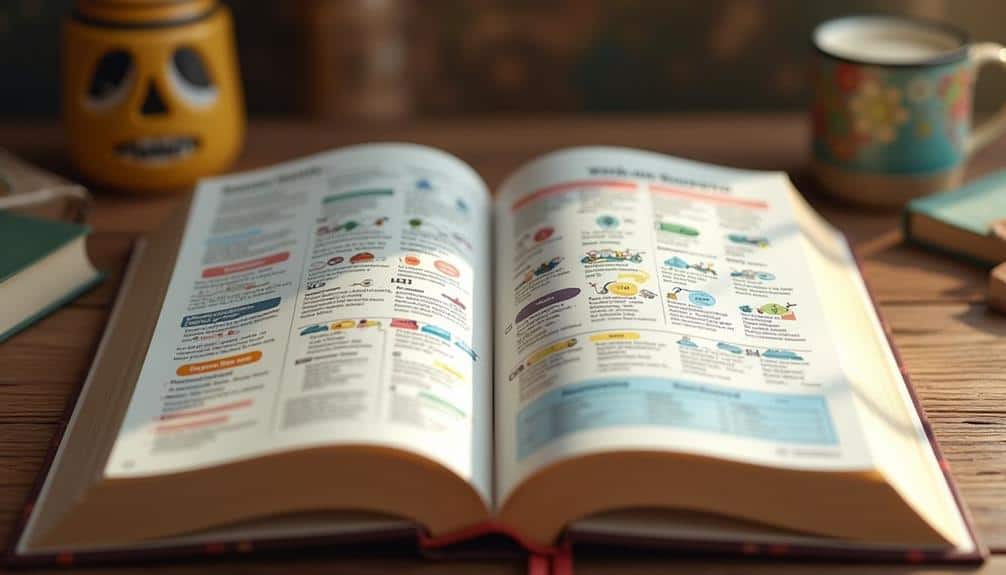Introduction

Understanding the foundational rules of reading in Russian is essential for any learner aiming to achieve fluency and accuracy in the language.
This article will provide a thorough overview of key elements, including the pronunciation of stressed and unstressed vowels, the differentiation between hard and soft consonants, and the critical role of stress and intonation.
The importance of understanding reading rules in Russian
Grasping the intricate reading rules of the Russian language is a vital cornerstone for any beginner starting on this linguistic journey. Mastery of these rules sets the foundation for effective language learning, particularly in improving reading comprehension and accurate pronunciation.
Understanding the distinctions between stressed and unstressed vowels, as well as hard and soft consonants, is fundamental. These elements play a significant role in how words are perceived and understood.
Pronunciation tips and phonetic exercises should be integral components of beginner strategies. Engaging in these practices can greatly enhance a learner’s ability to internalize the nuances of the Russian language. For instance, phonetic exercises focusing on vowel reduction and consonant palatalization can aid in developing a more authentic accent and fluency.
Moreover, the importance of stress and intonation cannot be overstated. In Russian, stress can alter the meaning of a word entirely, making it essential for learners to pay close attention to these aspects.
Overview of the article’s content
Building upon the foundational importance of understanding reading rules in Russian, this article aims to guide learners through the essential elements vital for mastering Russian reading. The journey to language acquisition in Russian is marked by distinct pronunciation challenges and the need for a strong grasp of reading comprehension.
This article will explore several pivotal areas, including the intricacies of the Cyrillic alphabet, with a special focus on differentiating between stressed and unstressed vowels. In addition, learners will be introduced to the nuanced distinction between hard and soft consonants, which is fundamental to accurate pronunciation.
To facilitate this learning process, practical phonetic exercises will be presented, enabling readers to practice and internalize these pronunciation norms. A dedicated section on the role of stress and intonation will illustrate how these elements affect meaning and communication, essential for maneuvering through Russian texts effectively.
Additionally, the article will examine the cultural influences embedded in the language, offering insights that enrich the reading experience. By integrating these components, learners will be equipped with a thorough toolkit to overcome common obstacles, thereby advancing their proficiency and confidence in Russian reading.
The Russian Alphabet
The Russian alphabet, derived from the Cyrillic script, consists of 33 letters and presents a distinct set of phonetic rules compared to the Latin alphabet.
Russian vowels and consonants have unique characteristics, with specific rules governing their pronunciation, particularly regarding stress and softness.
Understanding these differences is essential for accurate reading and effective communication, as it forms the foundation for mastering the Russian language.
Cyrillic alphabet and its differences from Latin
One of the initial hurdles for learners of Russian is familiarizing themselves with the Cyrillic alphabet, which consists of 33 letters. Unlike the Latin alphabet, the Cyrillic script offers a unique and rich tapestry of letter formation, deeply rooted in the alphabet history dating back to the 9th century.
The Cyrillic alphabet was developed by Saints Cyril and Methodius, whose innovative script aimed to transcribe the sounds of the Slavic language accurately, thereby aiding in the language evolution of the region.
Each letter in the Cyrillic alphabet has a distinct phonetic representation, making it an essential foundation for mastering Russian reading. While some letters resemble those in the Latin alphabet, their pronunciations often differ, demanding a focused approach to learning.
For instance, the Cyrillic “Р” corresponds to the Latin “R” in sound but appears as “P” in form, potentially confusing new learners.
Vowels and consonants in Russian
Mastering the intricacies of Russian vowels and consonants is fundamental for anyone serious about learning the language. The Russian alphabet comprises 33 letters, each representing distinct phonetic sounds, which demand careful attention to detail.
Vowel harmony plays a key role in Russian, as vowels can be either hard or soft, impacting the pronunciation of adjacent consonants. Understanding these subtle nuances is essential for accurate phonetic transcription.
Consonant clusters, common in Russian, present unique challenges. Unlike in English, where clusters are relatively simple, Russian clusters can be complex and require precise articulation. Mastery of these clusters is critical for fluent reading and speaking.
Diphthong pronunciation in Russian is relatively straightforward compared to other languages; however, it requires consistent practice to achieve clarity. Learners must familiarize themselves with the syllable structure, which typically follows a consonant-vowel pattern but can vary, influencing how words are divided and pronounced.
Incorporating these elements into your study regimen will greatly enhance your reading proficiency. By focusing on vowel harmony, consonant clusters, diphthong pronunciation, and syllable structure, you can navigate the complexities of Russian phonetics with confidence and precision.
Vowel Sounds

Understanding the intricacies of vowel sounds in Russian is fundamental for accurate pronunciation and comprehension.
In Russian, the pronunciation of vowels can vary greatly depending on whether they are stressed or unstressed, with stressed vowels being pronounced more clearly and unstressed vowels often reduced.
Additionally, the position of a vowel within a word can influence its sound, making it essential for learners to familiarize themselves with these patterns to achieve fluency.
Stressed and unstressed vowels
Delving into the intricacies of Russian vowel sounds, it becomes evident that stressed and unstressed vowels play a vital role in accurate pronunciation and comprehension. In Russian, vowel length and vowel harmony are important aspects that influence the overall syllable structure and meaning of words. When a vowel is stressed, it is pronounced more distinctly and with greater intensity, affecting its vowel placement within the word. This stress creates a vowel contrast that can alter meaning drastically, making it imperative for learners to identify stress patterns correctly.
Unstressed vowels, on the other hand, undergo reduction, where their pronunciation becomes less clear and more centralized. This reduction is a key feature of the Russian language, contributing to its unique rhythm and flow.
Mastering the distinction between stressed and unstressed vowels is essential for achieving fluency and enhancing reading skills. By focusing on the stress patterns and understanding how vowel harmony operates within different syllable structures, learners can greatly improve their ability to read and speak Russian with precision.
Encouraging innovation in learning, this approach not only aids in comprehension but also paves the way for more effective communication in Russian.
Pronunciation of vowels in different positions
A critical component of mastering Russian reading lies in the nuanced pronunciation of vowels in different positions within a word. Understanding vowel position effects is essential, as vowels can exhibit significant variations depending on their placement and stress. For instance, unstressed vowels often undergo vowel length variations, resulting in shorter and sometimes indistinguishable sounds compared to their stressed counterparts. This phenomenon is particularly evident with the vowels “о” and “а,” which can sound similar when unstressed.
Additionally, regional vowel pronunciations can introduce further complexity. Variations in vowel sounds may occur across different Russian-speaking regions, affecting the learner’s ability to recognize and produce the correct sounds.
Diphthongs in Russian, though less common than in English, also play a role in pronunciation, blending two vowel sounds into one and requiring careful attention.
Silent vowel occurrences, though rare, are another aspect to take into account. In some instances, vowels may be written but not pronounced, depending on their position in a word.
Mastering these intricacies will greatly enhance your reading fluency and overall comprehension, allowing you to navigate the rich tapestry of the Russian language with confidence and precision.
Vowel Reduction
Vowel reduction in Russian is a critical aspect of mastering the language, particularly as it affects the pronunciation of unstressed vowels.
In unstressed positions, vowels such as ‘о’ and ‘а’ often transform into a more neutral sound, akin to the English schwa, which can greatly alter the word’s pronunciation.
To build proficiency, learners should practice with examples like “молоко” (milk) and “город” (city), noting how the vowels shift depending on their stress placement.
Reduction of unstressed vowels
Understanding vowel reduction is pivotal for achieving proficiency in Russian reading. Vowel reduction techniques are essential in maneuvering the complexities of unstressed vowels, greatly impacting both pronunciation and comprehension.
In Russian, common vowel reductions occur primarily with the vowels ‘о’ and ‘е’. When unstressed, ‘о’ often sounds like ‘a’, and ‘е’ can resemble ‘и’. These transformations are not merely phonetic nuances; they are critical for accurate reading and speaking.
The effects on comprehension are profound. Mispronouncing unstressed vowels can lead to misunderstandings, as words may be confused with entirely different terms. For example, the word “замок” (castle) and “замок” (lock) differ in stress and vowel reduction, altering their meanings.
Exercises for reduction are indispensable for learners. Repetitive practice with listening and speaking drills helps internalize these changes, fostering a more natural and intuitive grasp of Russian phonetics.
Historical vowel changes have shaped modern pronunciation rules, underlining the importance of understanding these patterns for contemporary language use. Engaging with these vowel reduction techniques will empower learners to read and communicate with greater accuracy and confidence.
Examples and practice
Building on the foundational understanding of vowel reduction, practical examples and targeted exercises will solidify this knowledge. Russian learners must internalize the nuanced shift in vowel sounds when unstressed. For instance, the letter “о” in stressed syllables sounds like “o” in “more,” but in unstressed positions, it often resembles “a” in “sofa.”
To master this, one effective reading technique involves practicing minimal pairs such as “молоко” (milk), where the second “о” sounds like “a.” Common mistakes include overemphasizing unstressed vowels, which can obscure meaning. Pronunciation tips are essential: listen to native speakers and mimic their intonation patterns.
Vocabulary building becomes more effective when learners recognize these vowel variations in context, enhancing both comprehension and retention. Phonetic exercises are indispensable. Engage in activities like reading aloud and recording yourself, then compare your pronunciation with native speakers.
Utilize apps that focus on phonetic drills to refine your auditory discrimination skills. By integrating these methods, beginners can overcome initial hurdles and advance towards fluency with confidence. This structured approach not only improves reading techniques but also fosters a deeper, more intuitive grasp of Russian phonology.
Consonant Sounds
Consonant sounds in Russian present a unique challenge due to the distinction between hard and soft consonants, and the phenomenon of palatalization.
Palatalization, where the tongue moves closer to the hard palate, markedly alters the sound and meaning of words, making it essential for learners to recognize and produce these variations accurately.
Hard and soft consonants
When delving into the intricacies of Russian phonology, one quickly encounters the fundamental distinction between hard and soft consonants, a concept essential to mastering the language. Russian consonants can be classified into two categories: hard (твёрдые) and soft (мягкие). The difference hinges on palatalization, where the soft consonants are pronounced with a slight elevation of the middle part of the tongue towards the hard palate.
For instance, the hard consonant “т” in “там” (there) contrasts with the soft consonant “ть” in “тень” (shadow). Mastering these distinctions is essential as they can alter word meanings. Pronunciation tips involve paying close attention to the following vowels: “е,” “ё,” “и,” “ю,” and “я,” which typically signal that the preceding consonant is soft.
Innovative language exercises, such as minimal pair drills (e.g., “брат” vs. “брать”), help learners internalize these differences. By practicing with native speakers or using language apps that provide immediate feedback, one can refine their pronunciation and comprehension.
Emphasizing hard and soft consonants early in your study will greatly elevate your proficiency in Russian reading and speaking.
Palatalization and its effects
Understanding palatalization is key to mastering the nuanced sounds of Russian consonants. Palatalization, a fundamental aspect of Russian phonology, involves the softening of consonants by raising the tongue towards the hard palate, creating what are known as soft consonants. This subtle yet significant alteration affects pronunciation variations and can change the meaning of words, underscoring its linguistic influence.
In Russian, palatalization rules dictate that certain consonants can become soft when followed by the vowels я (ya), е (ye), ё (yo), ю (yu), и (i), or the soft sign ь (‘). For instance, the consonant ‘н’ (n) in “сон” (son – sleep) becomes ‘нь’ (ny) in “сень” (sen’ – shade). Such examples usage highlights the critical nature of correctly interpreting these shifts.
Engaging with these distinctions enables learners to grasp the rich subtleties of Russian pronunciation, fostering a deeper appreciation for the language’s complexity.
Voiced and Voiceless Consonants
In mastering Russian reading, understanding the assimilation of voiced and voiceless consonants is essential for accurate pronunciation.
In Russian, consonants at the end of words are typically pronounced as voiceless, a rule that often surprises learners accustomed to the Latin alphabet.
Assimilation of voiced and voiceless consonants
Mastering the assimilation of voiced and voiceless consonants in Russian is a critical step towards achieving fluent pronunciation. Consonant assimilation occurs when a consonant changes its voicing to match that of an adjacent consonant, creating a more fluid and natural sound in speech.
This phenomenon is particularly significant in Russian, where voiced pairs such as [б] (b) and [п] (p), or [д] (d) and [т] (t) transform based on their phonetic environment.
For example, in the word “сказка” (fairy tale), the voiced [з] (z) becomes the voiceless [с] (s) due to the following voiceless [к] (k). Such phonetic examples highlight the importance of understanding voiced and voiceless pairs.
To master consonant assimilation, learners should engage in targeted practice exercises, such as repeating words with varied consonant combinations and listening to native speakers for accurate modeling.
Pronunciation of consonants at the end of words
A crucial aspect often overlooked by novice learners is the pronunciation of consonants at the end of words in Russian. This fundamental component greatly influences phonetic clarity and overall fluency. In Russian, consonant endings undergo specific sound shifts depending on their position and voicing. Voiced consonants, such as “б” (b) or “г” (g), become devoiced at the end of words, transforming into their voiceless counterparts “п” (p) and “к” (k), respectively. This phenomenon, governed by word final rules, guarantees a more fluid and natural syllable structure.
For instance, the word “стол” (stol – table) is pronounced with a final “л” (l) that remains voiced. Conversely, the word “гриб” (grib – mushroom) ends with a “б” (b) that shifts to a voiceless “п” (p), rendering it “грип.”
Mastering these sound shifts is crucial for clear communication and accurate pronunciation. By focusing on the nuances of consonant endings, learners can achieve greater phonetic clarity and adapt to the rhythmic patterns of Russian speech. Embracing these word final rules not only enhances reading comprehension but also lays a solid foundation for advanced language proficiency.
Stress and Intonation

Understanding the importance of stress in Russian words is fundamental to mastering the language, as stress placement can alter the meaning of a word entirely.
Stress patterns in Russian are notoriously unpredictable and can vary greatly, making it essential for learners to familiarize themselves with common patterns and exceptions.
Importance of stress in Russian words
Often overlooked by beginners, the stress in Russian words plays a pivotal role in both pronunciation and meaning. Stress placement strategies are essential to mastering the language, as the position of stress can alter the word’s definition entirely. For instance, “замок” (castle) and “замок” (fasten) differ only in their stress placement, demonstrating the profound impact on meaning.
Understanding common stress patterns aids learners in predicting stress positions, although Russian stress is notoriously unpredictable compared to languages like Spanish or Italian.
Stress in verbs presents unique challenges for learners due to its variability across different tenses and conjugations. For example, the verb “писать” (to write) becomes “пишу” (I write), shifting the stress. This variability necessitates consistent practice and exposure to native speakers for effective learning.
Despite these challenges, embracing the nuances of stress in Russian fosters accurate pronunciation and comprehension. Innovative learners can leverage technology, such as language apps and audio resources, to internalize correct stress patterns.
Stress patterns and their variations
Mastering the intricate stress patterns and their variations is fundamental to achieving fluency in Russian. Unlike many languages, Russian places a significant emphasis on stress placement, which can dramatically alter the meaning of a word. Understanding these stress variations is essential for accurate pronunciation and comprehension.
Stress placement in Russian is not fixed, and it can shift from one syllable to another in different forms of the same word, creating a dynamic and challenging learning environment. For example, the word “замок” (castle) becomes “замок” (lock) when the stress is shifted. This illustrates the stress significance in conveying the correct meaning.
Additionally, unstressed syllables undergo vowel reduction, where vowels like “о” are pronounced closer to “а,” adding another layer to mastering pronunciation. Adhering to stress rules is paramount. While there are general patterns, exceptions abound, necessitating diligent practice and exposure.
Learners should engage with diverse auditory resources to internalize these stress patterns effectively. By embracing this complex aspect of the Russian language, students innovate their approach to learning, ensuring not only accuracy but also a deeper, more nuanced understanding of Russian.
Intonation Patterns
Mastering intonation patterns is essential for achieving fluency in Russian reading and speech.
Russian intonation comprises distinct patterns for declarative, interrogative, and exclamatory sentences, each contributing to the overall meaning and emotional tone of the utterance.
Declarative, interrogative, and exclamatory intonation
Intonation patterns in the Russian language play a pivotal role in differentiating between declarative, interrogative, and exclamatory sentences, thereby greatly impacting the conveyed meaning. Mastering these patterns not only enhances clarity but also allows for nuanced emotional expression and rhythm variation, both of which are essential for effective communication.
In declarative sentences, the intonation typically remains relatively flat with a slight fall at the end, ensuring that statements are delivered with confidence and clarity.
Interrogative sentences, on the other hand, often feature a rising intonation towards the end, signaling a question. This rise in pitch serves as an auditory cue that prompts the listener to recognize the inquisitive nature of the sentence.
Exclamatory sentences exhibit a marked rise in intonation, emphasizing strong emotions such as surprise, excitement, or urgency.
Understanding and applying these intonation patterns can considerably enhance one’s ability to convey and interpret emotional nuances in Russian. By practicing these distinct intonation patterns, learners can improve their reading comprehension and spoken fluency, ultimately achieving a more natural and expressive command of the language.
Embrace the rhythm variations and emotional depth that intonation offers to truly master Russian reading and communication.
Practicing intonation in sentences
Building on the understanding of declarative, interrogative, and exclamatory intonation patterns, it’s imperative for learners to engage in practical exercises to internalize these auditory cues. Intonation exercises play a pivotal role in mastering sentence variation and enhancing expressive reading. By practicing pitch modulation, learners can effectively convey different emotional nuances, which is essential for authentic communication in Russian.
To begin, focus on simple sentences and consciously alter the pitch to reflect various intonation patterns. For instance, practice raising the pitch at the end of a sentence to form a question, or lowering it to convey a statement. This methodical approach helps in distinguishing between different types of sentences and their corresponding emotional emphasis.
Additionally, pairing these exercises with expressive reading of Russian texts can greatly improve comprehension and fluency. Emulate native speakers by listening to audio recordings and mimicking their intonation. This auditory mimicry reinforces correct pitch modulation and emotional expression.
Innovative learners should also explore digital tools and apps designed for intonation practice. These resources provide instant feedback, allowing for rapid improvement and a deeper understanding of Russian intonation patterns.
Reading Compound Words

In the domain of Russian reading, understanding compound words is pivotal for advancing language proficiency.
Compound words in Russian are formed by combining two or more words, often altering pronunciation and stress patterns in the process.
Mastering the nuances of these combinations can considerably enhance both your reading fluency and overall comprehension.
Combining words to form compound words
Mastering the concept of compound words is a pivotal step in advancing one’s Russian reading skills. Compound word formation in Russian involves combining two or more words to create a new term with a distinct meaning. Examples of compounds can be seen in everyday language, such as “самолет” (samolet, airplane), which combines “само” (self) and “лет” (flight). Understanding these formations enhances comprehension and fluency.
When examining usage in sentences, consider the compound “водопровод” (vodoprovod, water supply), which combines “вода” (water) and “провод” (conduit). For instance, “В нашем доме новый водопровод” translates to “Our house has a new water supply,” illustrating practical application.
Common compound types include nouns, adjectives, and verbs. Recognizing these compounds involves identifying root words and suffixes. Tips for recognition include analyzing context and familiarizing oneself with common prefixes and suffixes used in compound word formation.
Encouragingly, the innovation in mastering compounds lies in recognizing patterns and applying them creatively. By integrating these principles, learners can greatly enhance their ability to read and understand complex Russian texts, paving the way for deeper linguistic and cultural appreciation.
Pronunciation of compound words
A key step in mastering Russian reading is the accurate pronunciation of compound words, an area where many learners initially struggle. Compound word formation in Russian often combines two or more words to create a new term with a distinct meaning, such as “солнцезащитные” (sun-protection) or “водопровод” (water supply). These words not only expand vocabulary but also reflect the rich cultural significance embedded in the language.
Pronunciation challenges arise due to the amalgamation of vowels and consonants, which can obscure stress patterns and lead to misinterpretation. For instance, the compound word “лесопарк” (forest park) requires the learner to correctly stress the second syllable to maintain its meaning. Understanding the grammatical implications of compound words is essential, as the stress often shifts, altering the syntactic structure.
Common compound examples include “детсад” (kindergarten) and “железнодорожный” (railway-related), each showcasing the intricacies of merging words while adhering to grammatical rules.
To overcome these challenges, focus on listening to native speakers and practicing consistently. Mastering compound word pronunciation not only enhances reading comprehension but also deepens your cultural connection to the Russian language, fostering a more meaningful and innovative learning experience.
Encouragement for continued practice and improvement
Despite the initial challenges that come with learning to read Russian, consistent practice and dedication will yield significant improvements over time. Adopting effective reading strategies is paramount; start by focusing on foundational elements such as mastering the Cyrillic alphabet and understanding vowel and consonant sounds. Regular phonetic exercises will help solidify these basics, making complex texts more approachable.
Vocabulary expansion should be a continuous goal. Incorporate new words through diverse methods, such as flashcards or language apps, and contextualize them within sentences to enhance retention. Listening practice is equally essential. Engage with Russian audio resources—podcasts, audiobooks, or music—to attune your ear to natural speech patterns and intonation. This auditory engagement supports your reading fluency and comprehension.
Immersing yourself in the language environment can accelerate your progress. Whether through reading Russian literature, participating in language exchange programs, or even virtual immersion experiences, such activities will expose you to authentic language use and cultural nuances.
Conclusion
Mastering Russian reading requires a thorough understanding of several foundational elements such as the Cyrillic alphabet, vowel sounds, vowel reduction, consonant sounds, and the critical aspects of stress and intonation. Additionally, proficiency in reading compound words is essential. Consistent practice, exposure to native speakers, and engaging with various audio resources are indispensable for improving reading skills and overall language comprehension. With dedication and sustained effort, significant progress in mastering Russian reading can be achieved.




